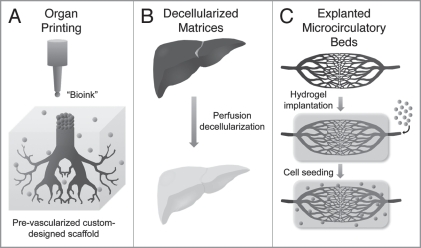Figure 2.
Biomaterial strategies for organ-level tissue engineering. Several emerging technologies in biomaterial scaffolds offer the promise of scaling up the size and complexity of tissue engineered constructs. “Organ printing” (A) is the use of inkjet printing techniques, which allows precise control over placement of cells and polymers deposited within a “bioink” and has been used to form tubular vascular structures. Recent advances in decellularization protocols using detergent perfusion have demonstrated promising results in the complete removal of cells from large visceral organs (B). These decellularized matrices maintain their structure and mechanical properties without containing immunogenic donor cells. The use of autologous explanted microcirculatory beds (EMBs) allows tissue engineers to circumvent the challenges of creating vasculature de novo (C). EMBs can be harvested, implanted within a hydrogel scaffold, manipulated ex vivo including cell perfusion and reimplanted at the site of tissue damage.

